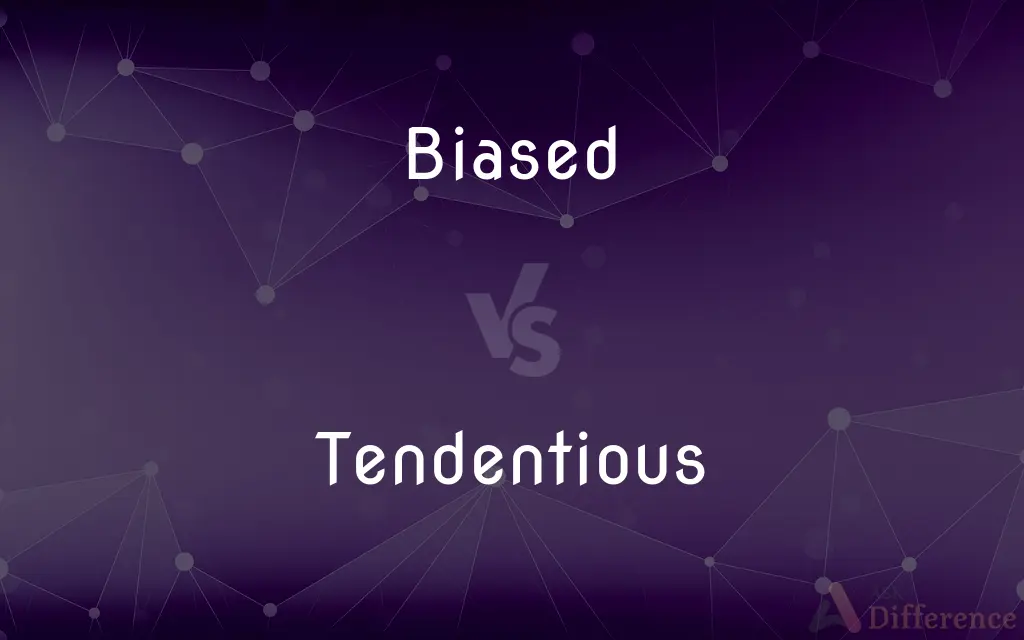Biased vs. Tendentious — What's the Difference?
By Maham Liaqat & Fiza Rafique — Updated on April 29, 2024
Biased implies a partiality that often unintentionally skews judgment; tendentious suggests deliberate intent to promote a controversial or partisan viewpoint.

Difference Between Biased and Tendentious
Table of Contents
ADVERTISEMENT
Key Differences
Biased often refers to a prejudice where one leans favorably or unfavorably towards a group, idea, or person based on personal opinions, which can affect objectivity and fairness in judgment. Tendentious, on the other hand, explicitly implies that something is designed to promote a particular cause or point of view, often disregarding the opposition.
The origin of bias is generally unconscious, stemming from cultural, societal, or experiential influences that subtly shape perspectives and reactions. Whereas tendentiousness is a conscious choice, with a clear agenda to influence outcomes or beliefs in a specific direction, usually in favor of or against a particular ideology.
In media, a biased report might unintentionally reflect the reporter's or the media's inherent prejudices or preferences. In contrast, a tendentious article is crafted to sway public opinion, often ignoring or misrepresenting facts to support its argument.
When discussing scholarly work, biased research may overlook certain data due to the researcher's preconceptions, potentially skewing the results. On the other hand, tendentious research deliberately selects, omits, or distorts data to validate a predetermined conclusion, often to advance a specific agenda.
In everyday conversation, someone might be biased based on their background or experiences without realizing it, affecting their viewpoints or decisions subtly. Tendentious statements, however, are typically deliberate, aiming to provoke or persuade others towards a specific stance.
ADVERTISEMENT
Comparison Chart
Intent
Often unconscious
Deliberately biased
Purpose
Skew judgment unintentionally
Promote a specific viewpoint
Manifestation in Media
Subtle, may not be evident
Clearly evident, often ignored
Research Implications
May overlook data unintentionally
Selects data to support a view
Communication Style
Unintentionally slanted
Aggressively persuasive
Compare with Definitions
Biased
Showing inclination or prejudice for or against someone or something.
His analysis was biased, favoring the team he supports.
Tendentious
Biased or partisan.
The article was written in a tendentious style that clearly favored one side.
Biased
A tendency to lean in a certain direction, either in favor of or against a particular thing.
Her decision was biased by her personal feelings.
Tendentious
Marked by a strong inclination towards a particular point of view.
The documentary was criticized for being tendentious and ignoring facts.
Biased
Having or showing an unfair tendency to believe that some people, ideas, etc., are better than others.
The teacher was biased against students who were not from her country.
Tendentious
Advocating a controversial viewpoint.
Her tendentious speeches often incite heated debates.
Biased
Influenced by personal feelings or opinions in considering facts.
His biased opinion did not take the actual statistics into account.
Tendentious
Designed to influence opinion.
His arguments were clearly tendentious, aiming to sway the audience.
Biased
Unfairly prejudiced for or against someone or something.
The biased news coverage only highlighted one side of the story.
Tendentious
Expressing or intending to promote a particular cause or point of view, especially a controversial one.
His tendentious remarks during the meeting created discomfort among the attendees.
Biased
Marked by or exhibiting bias; prejudiced
Gave a biased account of the trial.
Tendentious
Expressing or intending to promote a particular cause or point of view, especially a controversial one
A tendentious reading of history
Biased
Exhibiting bias; prejudiced.
The newspaper gave a biased account of the incident.
Tendentious
Marked by or favoring a particular point of view; partisan
A tendentious account of the recent elections.
Biased
Angled at a slant.
The table had a biased edge.
Tendentious
Having a tendency; written or spoken with a partisan, biased or prejudiced purpose, especially a controversial one.
Biased
(electrical engineering) On which an electrical bias is applied.
Tendentious
Implicitly or explicitly slanted.
As a supporter of the cause, his reports were tendentious in the extreme.
Biased
(statistics) Exhibiting a systematic distortion of results due to a factor not allowed for in its derivation; skewed.
Tendentious
Having or marked by a strong tendency especially a controversial one;
A tendentious account of recent elections
Distinguishing between verifiable fact and tendentious assertion
Biased
Simple past tense and past participle of bias
She biased them against him for no apparent reason.
Biased
Favoring one person or side over another;
A biased account of the trial
A decision that was partial to the defendant
Biased
Excessively devoted to one faction
Common Curiosities
Can someone be biased and tendentious at the same time?
Yes, someone can exhibit bias by generally being partial and also be tendentious by deliberately promoting a contentious viewpoint.
Why is it important to understand whether an argument is biased or tendentious?
Recognizing this can help evaluate the reliability and objectivity of the information, ensuring more informed decision-making.
What is the impact of tendentious political campaigns?
They can significantly influence public opinion and voting behaviors, often focusing on divisive issues.
What are the consequences of tendentious journalism?
It can lead to misinformation, increased polarization, and distrust in media institutions.
What is the main difference between biased and tendentious?
Biased generally indicates a lack of neutrality that can be unconscious, whereas tendentious is intentionally partial and often controversial.
Can tendentious behavior affect workplace harmony?
Yes, promoting controversial opinions aggressively can lead to conflicts and reduce workplace cohesion.
How do biased and tendentious attitudes influence educational content?
They can skew the presentation of information, leading to an imbalanced education that might favor certain viewpoints.
How can you identify if a news article is biased or tendentious?
If it subtly favors one side, it may be biased. If it aggressively pushes a specific agenda, it is likely tendentious.
How does social bias differ from tendentiousness?
Social bias is often a product of societal norms and may not be intentional, while tendentiousness is a deliberate stance to persuade or influence.
Is tendentious always negative?
While often seen negatively, tendentiousness can be effective for advocating necessary social changes if based on ethical reasoning.
How can one mitigate their own biased or tendentious tendencies?
Awareness, open-mindedness, and engaging with diverse perspectives can help mitigate these tendencies.
How do biased and tendentious attitudes manifest in scientific research?
Bias can lead to unintentional data oversight, while tendentiousness may involve manipulating data to support a hypothesis.
What is the difference between biased and tendentious writing?
Biased writing may unknowingly lean towards a viewpoint, whereas tendentious writing purposefully argues a biased opinion.
What role does personal experience play in biased judgments?
Personal experiences can subconsciously shape one’s biases, affecting judgments and decisions without overt intent.
Can cultural background influence biased and tendentious attitudes?
Yes, cultural influences can shape both unconscious biases and the propensity to adopt and promote specific tendentious views.
Share Your Discovery

Previous Comparison
Polymath vs. Autodidact
Next Comparison
Chorus vs. ChoirAuthor Spotlight
Written by
Maham LiaqatCo-written by
Fiza RafiqueFiza Rafique is a skilled content writer at AskDifference.com, where she meticulously refines and enhances written pieces. Drawing from her vast editorial expertise, Fiza ensures clarity, accuracy, and precision in every article. Passionate about language, she continually seeks to elevate the quality of content for readers worldwide.
















































